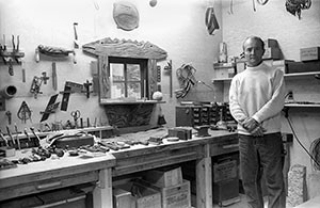Born 1922, Los Angeles, California
Died 1981, Danbury, Connecticut
H. C. (Horace Clifford) Westermann worked variously as a gandy dancer, sailor, acrobat, and carpenter. And he brought the considerable physicality demanded by these trades to his art. Westermann’s toned physique was adorned by tattoos, including a nautical swallow above each pectoral that commemorated his naval service during World War II and the Korean War. The artist’s meticulously crafted wooden sculptures of buildings, ships, and boxes reflect his body. Strong and sturdy, their surfaces are “tattooed” with symbolic designs: anchors, cartoon characters, and the recurring Jolly Roger ensign of pirates.
Though Westermann favored vernacular woodworking techniques and architectural forms uncommon in the tradition of fine art sculpture, he completed formal artistic education at the School of the Art Institute of Chicago in 1954. His work was first exhibited alongside fellow alumni known as the “Monster Roster,” including Leon Golub and Cosmo Campoli, who shared an existential perspective growing out of wartime experiences and an interest in “primitive” art from Africa and Oceania. I Wonder if I Really Love Her?, a pregnant female torso built of jagged, stacked sheets of laminated plywood, resembles Dogon fertility statues as well as the rough, tormented figures in the work of Golub and Campoli. Disillusionment with war is evident in Westermann’s Untitled (“Unusual Physician”), a padlocked silver box decorated with blood-red fingerprints and Westermann’s military dog tag. Inside, a miniature scene of an ailing patient treated by a one-eyed physician is a cryptic parable of society’s ills.
The next generation of Chicago artists, who rose to prominence in the late 1960s, particularly Jim Nutt, was stimulated by Westermann’s staunch nonconformity. But Westermann left Chicago in 1961 and settled in Brookfield, Connecticut, spending a year in San Francisco in 1964. Bay Area artists, including Roy De Forest, also admired Westermann’s celebration of discarded vernacular forms, dark humor, and exquisite craftsmanship. The masterful dovetailed joints and hand-sanded finish of Walnut Box showcase the beauty of walnut wood—qualified by a pun: the box is filled with walnuts in the shell, stamped with their brand name, alluding to a consumer culture that privileges expediency over quality.
Antonia Pocock
Garvey, Timothy J. “Mysteriously Abandoned New Home: Architecture as Metaphor in the Early Sculpture of H. C. Westermann.” American Art 10, no. 1 (Spring 1996): 42–63.
McCarthy, David. H. C. Westermann at War: Art and Manhood in Cold War America. Newark: University of Delaware Press, 2004.
Rooks, Michael, and Lynne Warren. H. C. Westermann: Exhibition Catalogue and Catalogue Raisonné of Objects. Chicago: Museum of Contemporary Art, with Harry N. Abrams, Inc., New York, 2001.
